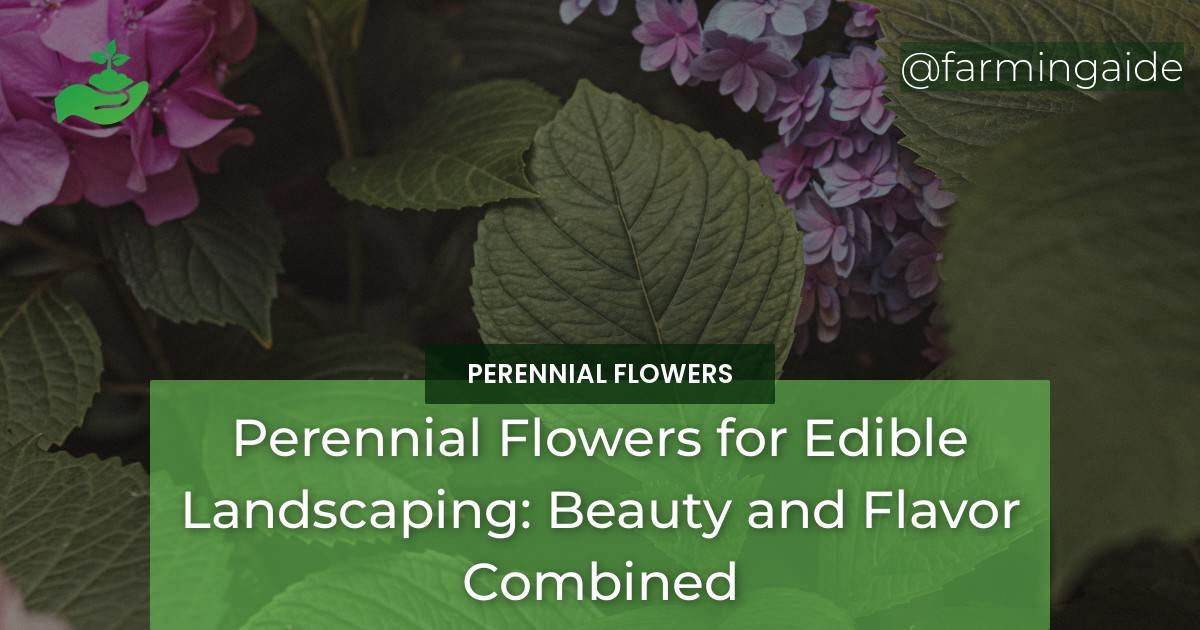Perennial flowers not only add beauty to your garden, but some of them are edible too! Imagine having a garden that not only provides visual pleasure but also flavor-packed treats. This article aims to introduce you to some of the most beautiful and delicious perennial flowers that you can plant in your garden. The flowers we’ve chosen for this article are not only ornamental but also edible, making them perfect for edible landscaping. In this article, we’ll take a closer look at what perennial flowers are, the benefits of edible landscaping, the best edible perennial flowers out there, growing tips for these flowers, and more. So, without further ado, let’s get started!
What are Perennial Flowers?
Perennial flowers are plants that live for more than two years and usually return to bloom year after year. They are considered the backbone of many garden landscapes due to their longevity and resilience. Unlike annual flowers that need to be replanted every year, perennials offer gardeners a low-maintenance option that’s perfect for those who don’t have time to replant each season.
There are a variety of perennial flowers available, ranging from groundcovers to tall spikes of flowers. Examples of perennial flowers include coneflower, daisy, black-eyed Susan, and more.
Benefits of Edible Landscaping
Edible landscaping is the practice of incorporating edible plants into your landscape design. It’s a great way to make the most of your garden space, and it provides you with fresh, organic produce that you can enjoy year-round. There are several benefits to edible landscaping:
- It can help you save money on groceries
- It provides you with fresh, healthy produce
- It’s a great way to get kids excited about gardening and healthy eating
- It’s an eco-friendly way to garden
- It can provide a unique and beautiful garden design
ALSO READ
Perennial Flowers that are Ornamental and Edible
Here are some of the best perennial flowers that are both ornamental and edible:
Daylilies
Daylilies are not only beautiful, but they are also edible. The petals have a slightly sweet flavor, and the buds and flowers can be eaten raw or cooked. The flowers come in a variety of colors, including orange, yellow, and pink.
Daylilies are easy to grow and don’t require much maintenance. They prefer full sun and well-drained soil. They are also drought-tolerant, making them an excellent choice for those living in dry areas.
Roses
Roses are a classic garden flower, but did you know that they are also edible? The petals have a slightly sweet flavor and can be used to make tea, syrup, or jam. They are also a beautiful addition to salads or desserts.
Roses are relatively easy to grow and thrive in full sun. They prefer well-drained soil and should be watered regularly.
Nasturtiums
Nasturtiums are not only edible, but they also add a pop of color to your garden. The flowers have a peppery flavor that’s perfect for salads, and the leaves are also edible and have a slightly sweet taste.
Nasturtiums are easy to grow and prefer full sun. They can grow in either containers or in the ground and don’t require much maintenance.
Lavender
Lavender is a fragrant and beautiful perennial flower that’s also edible. The petals can be used to flavor desserts, tea, or as a garnish for salads. Lavender is also known for its calming properties and is often used in aromatherapy.
Lavender prefers full sun and well-drained soil. It’s a drought-tolerant plant and doesn’t require much maintenance once established.
Calendula
Calendula, also known as the pot marigold, is a bright and cheerful flower that’s also edible. The petals have a slightly spicy flavor and are often used in soups or stews. Calendula is also known for its medicinal properties and is often used in skin care products.
Calendula prefers full sun and well-drained soil. It’s a low-maintenance plant that’s perfect for beginner gardeners.
Bee Balm
Bee balm, also known as monarda, is a flowering plant that’s both beautiful and edible. The flowers can be used to make tea or infused in vinegar or oil. Bee balm is also attractive to bees, butterflies, and hummingbirds, making it an excellent addition to any pollinator garden.
Bee balm prefers full sun to partial shade and well-drained soil. It’s a low-maintenance plant that’s perfect for beginner gardeners.
Violets
Violets are a charming and fragrant flower that’s also edible. The flowers have a sweet flavor that’s perfect for desserts, and the leaves can be used in salads or cooked like spinach.
Violets prefer partial shade and well-drained soil. They are relatively low-maintenance and can self-seed to produce more plants.
Tips for Growing Perennial Flowers
Here are some suggestions for growing perennial flowers for edible landscaping:
- Choose plants that are well-suited to your climate and soil type
- Prepare the soil before planting by adding compost or organic matter
- Water regularly, especially during dry spells
- Fertilize with a balanced fertilizer in the spring and summer
- Prune back dead or damaged growth regularly
ALSO READ
How Can Perennial Flowers Enhance the Health of My Garden Through Companion Planting?
When it comes to maximizing garden health with perennials, companion planting with these long-lasting flowers can be beneficial. Perennial flowers can attract pollinators, repel pests, and enrich the soil, ultimately enhancing the overall health of your garden. Consider planting them alongside your other plants for a thriving, balanced ecosystem.
Conclusion
Incorporating edible perennial flowers into your landscape design is a great way to add beauty and flavor to your garden. Not only are these flowers ornamental, but they are also edible, making them perfect for edible landscaping. From daylilies to violets, there are plenty of options available for those looking to add some edible flowers to their garden. By following our tips for growing these flowers, you can enjoy fresh, organic produce right from your backyard.


